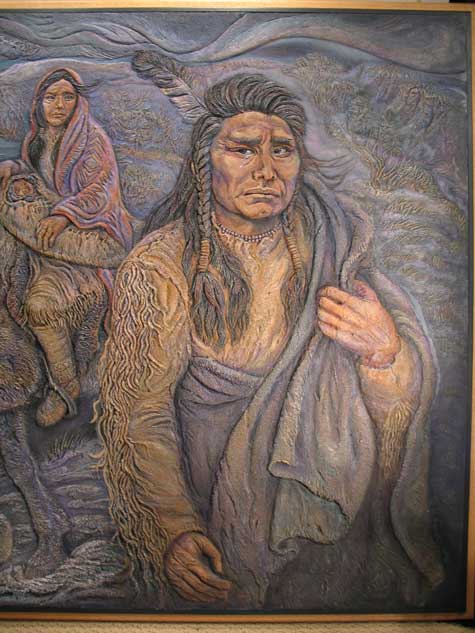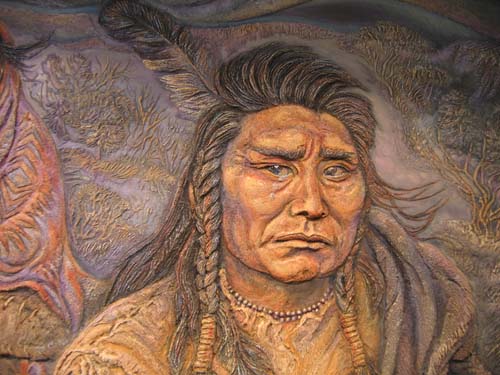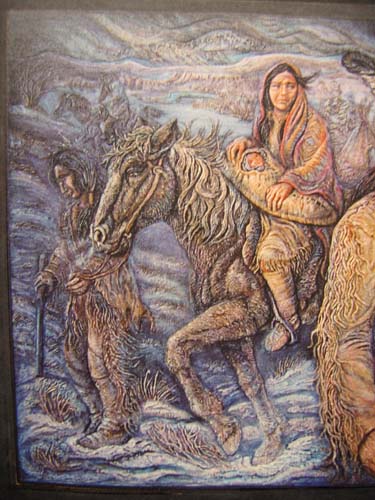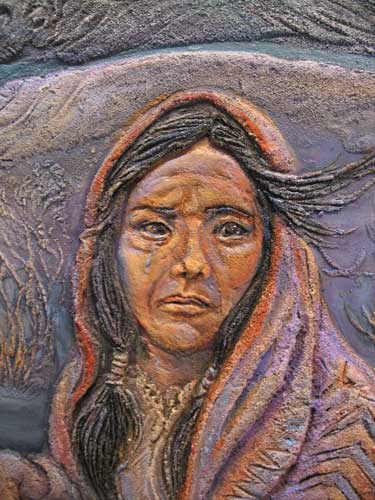The End of a Noble Journey
(approximately 4' x 5')
Chief Joseph, Nez Perce, sending his wife and baby (born during the battle of Clearwater, ID, July 1877) off to freedom in Canada before surrendering. I finished this September 11, 2001, for a show in Bozeman, MT September 14, 16. I had drawn the scene 28 years ago after viewing a documentary of the tragic injustice of the pursuit of the men, women, children and elderly with livestock and belongings from their beloved ancestral Willowa Valley (Oregon). This was a very emotional project. Then the September 11, 2001 tragedy.
|
The Nez Perce were one of the few tribes that helped Lewis & Clark and were described in a letter to the government as noble, handsome, intelligent, generous people who saved them from starvation and death, and they live in this beautiful Willowa Valley. All the government heard was “beautiful Willowa Valley.” Settlers who were welcomed by the Nez Perce wanted more land. General Howard took a treaty to get more land, but Chief Joseph refused to sign. Howard and Washington, angered by this refusal, finally said, “Enough of this Mother Earth talk,” and gave an order to vacate in 30 days to a reservation in Idaho. It was spring and very difficult for the tribe as livestock were giving birth.
Young braves angered by the order to vacate, killed several anti-Indian settlers. (One of the braves father had been killed by one of these settlers earlier.) The US Cavalry pursued the Tribe as they fled. The Nez Perce Trail took them from Willowa Valley battling through Idaho over treacherous Lolo Pass to Montana where they rested in Big Hole, Montana. Here a massacre occurred with a surprise attack by soldiers using cannon fire. Over 100 Nez Perce were killed and most of their belongings were lost in flight.
Their flight continued through Montana, peacefully trading with Bozeman ranchers and on through Yellowstone (which was designated as a National Park in 1872). They encountered tourists in the Park and briefly captured several. They were hoping their friends the Crow would help them, but to Joseph's dismay the Crow were assisting the Cavalry. Receiving no help from the Crow, the Tribal Council decided to make a run for Canada to link up with Sitting Bull's Sioux, who had fled to Canada after The Battle of Little Big Horn the year before.
This approximately 1,500 mile journey stopped 40 miles from freedom to rest at Bear Paw, Montana. Here an early October snowstorm occurred, compounding the misery of a starving and freezing people. A surprise attack at this location by a young, ambitious, General Miles led to negotiations and surrender of Chief Joseph, who chose to protect his 417 sick, wounded and elderly survivors. Over 200 of the more able Nez Perce, including Joseph's 11-year-old daughter, escaped to Canada. Some of the escapees were rounded up and returned to the group (There were over 18 battles fought during this flight.) |




